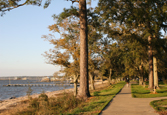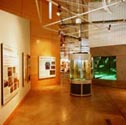DAY 1
Total Distance Traveled in Day 1: 32.5 miles
DAY 2
Directions from previous place: Upon disembarking the ferry, turn to the left, exiting Fort Morgan Historic Site and continuing approximately 22 miles into Gulf Shores. Turn left onto West 2nd Street and go to West 19th Avenue. Turn left and the museum is on the left.
Distance from Previous Site: 22 miles
Travel Time from Previous Site: 30 minutes
Suggested Time at This Site: 45 minutes
Travel Time from Previous Site: 30 minutes
Suggested Time at This Site: 45 minutes
 Just a few blocks north of the byway route, this local museum depicts this coastal community’s harried history of hurricanes and features frequently changing exhibits and photo displays that tell the story from the early days when settlers “lived off the sea and land” to today’s residents and visitors who “enjoy all the surf and sand.” Tour the quaint cottage and hear “A Shrimper’s Story,” listen to the Hurricane Hunters fly through a storm, and view a video from a special weather collection. » More Details
[/fusion_toggle]
Just a few blocks north of the byway route, this local museum depicts this coastal community’s harried history of hurricanes and features frequently changing exhibits and photo displays that tell the story from the early days when settlers “lived off the sea and land” to today’s residents and visitors who “enjoy all the surf and sand.” Tour the quaint cottage and hear “A Shrimper’s Story,” listen to the Hurricane Hunters fly through a storm, and view a video from a special weather collection. » More Details
[/fusion_toggle]
Directions from previous place: Return on West 19th Street to AL-180. Turn left and cross AL-59, then keep straight into Gulf State Park on AL-135. At the intersection of AL-182, turn left and drive approximately six miles to AL-161 and turn left. The Indian & Sea Museum is in the Orange Beach municipal complex, approximately one mile ahead on the left, on John Snook Drive.
Distance from Previous Site: 9 miles
Travel Time from Previous Site: 15 minutes
Suggested Time at This Site: 45 minutes
Travel Time from Previous Site: 15 minutes
Suggested Time at This Site: 45 minutes
 The museum houses local artifacts and memorabilia relating to our Native American and fishing heritage. Families of early fishermen have donated supplies and collectibles that make us mindful of the challenges and achievements in the early days of our fishing industry. Please note: The museum has limited hours of operation; please check times before your visit. » More Details
The museum houses local artifacts and memorabilia relating to our Native American and fishing heritage. Families of early fishermen have donated supplies and collectibles that make us mindful of the challenges and achievements in the early days of our fishing industry. Please note: The museum has limited hours of operation; please check times before your visit. » More Details
Directions from previous place: Continue north on SR-161 to SR-180 (Canal Road). Turn left and travel six miles to the Foley Beach Express and turn right. Travel across the toll bridge and continue to County Road 20, where you’ll take a right. Continue on County Road 20 until it takes a 90-degree left turn and becomes County Road 83. When you reach US-98 in Elberta, turn right and continue to the entrance of the museum on the left.
Distance from Previous Site: 15 miles
Travel Time from Previous Site: 20 minutes
Suggested Time at This Site: 1 hour
Travel Time from Previous Site: 20 minutes
Suggested Time at This Site: 1 hour
 The mission of the Baldwin County Heritage Museum is to preserve the culture of the farm communities of early Baldwin County through the creation of a home for historically significant buildings, documents and artifacts from community life. It is not filled with elaborate antiques or expensive collections—it holds bits and pieces collected from the daily lives of the men and women who built this county. » More Details
The mission of the Baldwin County Heritage Museum is to preserve the culture of the farm communities of early Baldwin County through the creation of a home for historically significant buildings, documents and artifacts from community life. It is not filled with elaborate antiques or expensive collections—it holds bits and pieces collected from the daily lives of the men and women who built this county. » More Details
Directions from previous place: Turn right onto US-98 through Elberta and into Foley. The Depot Museum is on the right in downtown Foley.
Distance from Previous Site: 5 miles
Travel Time from Previous Site: 10 minutes
Suggested Time at This Site: 45 minutes
Travel Time from Previous Site: 10 minutes
Suggested Time at This Site: 45 minutes
 The City of Foley was the early center of this agricultural region of Baldwin County. The depot and the railroad became the center of activity for the growing town of Foley and the railroad was vital to getting the produce to market. During shipping season, thousands of boxcars would pull out of Foley loaded with potatoes, corn, gladiolas, and many other types of agricultural products grown in the area. » More Details
The City of Foley was the early center of this agricultural region of Baldwin County. The depot and the railroad became the center of activity for the growing town of Foley and the railroad was vital to getting the produce to market. During shipping season, thousands of boxcars would pull out of Foley loaded with potatoes, corn, gladiolas, and many other types of agricultural products grown in the area. » More Details
Directions from previous place: Continue west on US-98 through Magnolia Springs. Just beyond the Fish River, the entrance to the Weeks Bay Estuarine Research Reserve’s interpretive center is on the left.
Distance from Previous Site: 6 miles
Travel Time from Previous Site: 10 minutes
Suggested Time at This Site: 1 hour
Travel Time from Previous Site: 10 minutes
Suggested Time at This Site: 1 hour
 Weeks Bay is one of only 27 National Estuarine Research Reserves in the country and offers an exceptional opportunity for travelers to enjoy the educational materials of the interpretive center or take to the boardwalks and enjoy the environment firsthand.
Weeks Bay is one of only 27 National Estuarine Research Reserves in the country and offers an exceptional opportunity for travelers to enjoy the educational materials of the interpretive center or take to the boardwalks and enjoy the environment firsthand.Estuaries represent some of the most sensitive and ecologically important habitats on Earth. They provide sanctuary for many species of waterfowl, store nutrients for larval and juvenile marine life, and serve as breeding grounds for many desirable species of ocean fish. As one of the largest estuaries in the country, the Mobile Bay system is the foundation for the environmental beauty and diversity found along Alabama’s Coastal Connection. » More Details
Directions from previous place: Turn left (west) from the interpretive center and travel on US-98, which turns into Scenic Route 98 and runs north along the coast. Follow that route into downtown Fairhope and Daphne.
Distance from Previous Site: 11 miles
Travel Time from Previous Site: 20 minutes
Travel Time from Previous Site: 20 minutes
 “Jubilee” is a cry that can be heard along the Eastern Shore of Mobile Bay, one of few places on earth where the phenomenon occurs. Crabs, fish and shrimp are compelled to the surface of Mobile Bay by rare environmental conditions. Eastern Shore residents are then compelled to the shore for the fish story of a lifetime! While you can’t plan your trip around these events, you can surely hear tell of some if you strike up a conversation with some locals as you stroll the pier in Fairhope or visit the waterfront municipal parks in Daphne, the “Jubilee City.”
“Jubilee” is a cry that can be heard along the Eastern Shore of Mobile Bay, one of few places on earth where the phenomenon occurs. Crabs, fish and shrimp are compelled to the surface of Mobile Bay by rare environmental conditions. Eastern Shore residents are then compelled to the shore for the fish story of a lifetime! While you can’t plan your trip around these events, you can surely hear tell of some if you strike up a conversation with some locals as you stroll the pier in Fairhope or visit the waterfront municipal parks in Daphne, the “Jubilee City.”
Total Distance Traveled in Day 2: 68 miles




 The drive along the westernmost portion of the byway takes you through the Grand Bay community. Long a farming community, pecan orchards, pasture lands and seasonal crops are the primary landscape here.
The drive along the westernmost portion of the byway takes you through the Grand Bay community. Long a farming community, pecan orchards, pasture lands and seasonal crops are the primary landscape here.
 Described as the “Seafood Capital of Alabama,” Bayou La Batre is a traditional fishing village. At the heart of town is the harbor, where fish and shrimp boats dock and boat builders and seafood processing plants line the shoreline. Each May brings the Blessing of the Fleet, which is a celebration of the shrimping season and a local cultural tradition.
Described as the “Seafood Capital of Alabama,” Bayou La Batre is a traditional fishing village. At the heart of town is the harbor, where fish and shrimp boats dock and boat builders and seafood processing plants line the shoreline. Each May brings the Blessing of the Fleet, which is a celebration of the shrimping season and a local cultural tradition.
 In the 1930s, Walter Bellingrath decided to do something a little different with his piece of waterfront property. Today, this world-renowned garden is an amazing display year-round. The 65-acre estate includes breathtaking seasonal gardens as well as river cruises between March and November. Tours of the Bellingrath Home, preserved with its 1930s décor, are also available.
In the 1930s, Walter Bellingrath decided to do something a little different with his piece of waterfront property. Today, this world-renowned garden is an amazing display year-round. The 65-acre estate includes breathtaking seasonal gardens as well as river cruises between March and November. Tours of the Bellingrath Home, preserved with its 1930s décor, are also available.  This county park is one of many waterfront parks along the byway. Each waterfront town (Bayou La Batre, Dauphin Island, Gulf Shores, Orange Beach, Fairhope and Daphne) has a public beachfront area for picnics and recreation. There are even public piers in Gulf Shores and Fairhope. This park overlooks the southern portion of the bay and offers boardwalks and interpretive signage. It is also a stop on the Alabama Coastal Birding Trail.
This county park is one of many waterfront parks along the byway. Each waterfront town (Bayou La Batre, Dauphin Island, Gulf Shores, Orange Beach, Fairhope and Daphne) has a public beachfront area for picnics and recreation. There are even public piers in Gulf Shores and Fairhope. This park overlooks the southern portion of the bay and offers boardwalks and interpretive signage. It is also a stop on the Alabama Coastal Birding Trail.
 The estuarium is an exciting educational facility highlighting the four key habitats of coastal Alabama: the Mobile Tensaw River Delta, Mobile Bay, the Barrier Islands and the Northern Gulf of Mexico. It includes the 10,000-square-foot exhibit hall and Living Marsh Boardwalk. This facility is a showcase of the plants, animals, and other natural resources found in the estuary and its surrounding marine habitats.
The estuarium is an exciting educational facility highlighting the four key habitats of coastal Alabama: the Mobile Tensaw River Delta, Mobile Bay, the Barrier Islands and the Northern Gulf of Mexico. It includes the 10,000-square-foot exhibit hall and Living Marsh Boardwalk. This facility is a showcase of the plants, animals, and other natural resources found in the estuary and its surrounding marine habitats.
 The Mobile Bay Ferry connects the Mobile and Baldwin County segments of the byway and also offers travelers a unique connection with the waters of Mobile Bay. The 30-minute trip across the bay gives an up-close look at the waters and a chance to view the recreational and commercial maritime endeavors ever-active in these waters.
The Mobile Bay Ferry connects the Mobile and Baldwin County segments of the byway and also offers travelers a unique connection with the waters of Mobile Bay. The 30-minute trip across the bay gives an up-close look at the waters and a chance to view the recreational and commercial maritime endeavors ever-active in these waters.